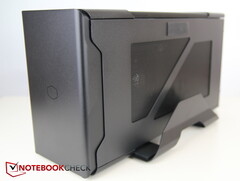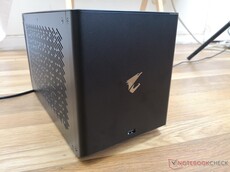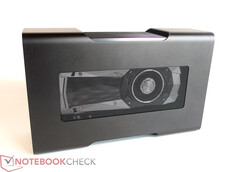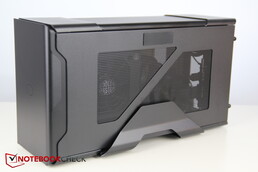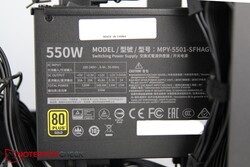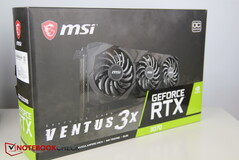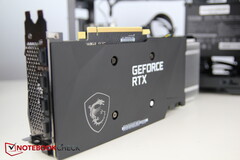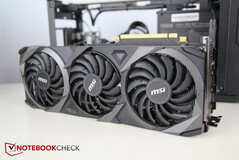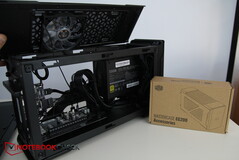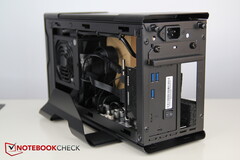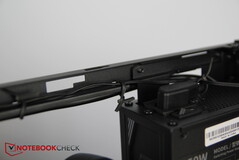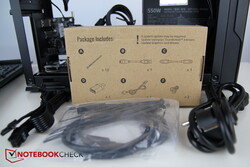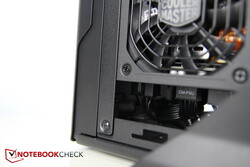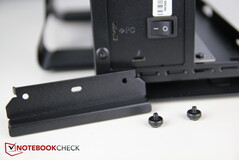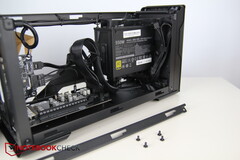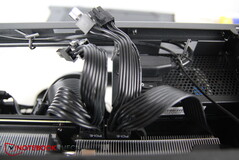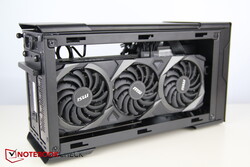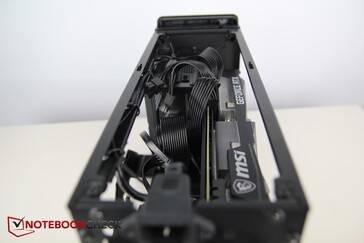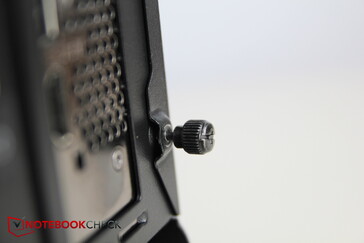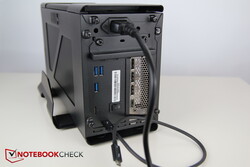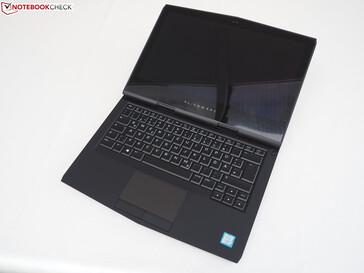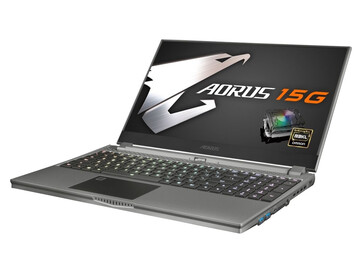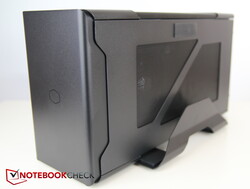Turning the lame office box into a gaming monster - that would be it! While desktop PCs can be upgraded to the latest GPU generation relatively easily, this is not possible with laptops due to their construction, especially since their internal GPUs do not reach the performance of their desktop counterparts from the start.
So, how about an external GPU case that takes full-fledged desktop graphics cards, powers them, and connects them to the laptop via a fast line to help it achieve unprecedented gaming performance? Raise the curtain on the MasterCase EG200 from Cooler Master.
OK, the idea is anything but new. External GPU enclosures have been around for a long time. In the past, lame USB ports limited the transferable performance of an external solution. However, with the latest Thunderbolt 3 (TB 3), the theoretical data throughput rate has increased to an extent that makes external solutions attractive again. Also, while not every office laptop has a Thunderbolt 3 port yet, at least they are becoming more common.
About four years ago, we reviewed the Razer Core and this year the Mini-eGPU ROG XG Mobile and the Aorus Gaming Box were added. Today we want to see if anything has improved since the Razer Core from four years ago and what the MasterCase EG200 does differently or not.
Specifications
- integrated 550 W V-Gold series power supply (60 W for USB-C + 10 W HDD + 3x 4.5 W USB-A = 83.5 W; over 450 W free for the GPU)
- GPU connection via Thunderbolt 3, JHL7440 controller
- Hot-swap hard drive dock for HDDs/SSDs in 3.5 or 2.5 inches
- Mac and PC compatible, Mac only AMD cards
- Full size cards up to 330 x 51 x 156 mm, 9.7 l
- Dedicated USB ports (3x USB-A 3.2 Gen1; 1x USB Micro-B 3.2 Gen 1), USB hub separate from Thunderbolt 3: maximum Thunderbolt bandwidth for GPU
- Laptop stand/holder
- MSRP of 349.99 Euros/~$420
Processing & GPU installation
The rather high weight is immediately noticed when unpacking the case, which is probably due to the sturdy metal design and the 550 W power supply. My kitchen scale, which usually weighs every laptop without any problems, was overtaxed ("err") with the MasterCase including the built-in GPU. A less accurate luggage scale came to 6.25 kg (~13.8 pounds, with RTX 3070)! Without the GPU, the case still weighs 5.2 kg (~11.5 lb), so it is really more suitable for stationary use.
As a graphics card, we use an MSI Ventus 3x GeForce RTX 3070 with triple fan design, so it has quite a considerable length. Of course, it is not included in the scope of delivery.
The assembly is not particularly difficult, but it does require some screwing, for which you need a Phillips screwdriver. First, the side panels and then the lid have to be removed; they are each secured with two screws. When removing the lid, you have to take care that there is a fan inside, whose cable is connected to the circuit board. Thus, the connector has to be disconnected from the PCB first to be able to remove the lid completely.
Inside is an accessories pack with a power, a MicroB and a USB-C cable as well as an adapter (USB-A to -C), cable ties and two screws for the GPU bezel.Free cables are secured along the casing with simple cable ties.
After removing two metal rails, the case is exposed for inserting the GPU. Our MSI model is over 30 cm (~11.8 inches) long and still doesn't quite exhaust the case, but almost, maximum GPUs up to a length of 330 mm (~13 in) fit inside. The GPU with its 2 slot bezels is carefully pressed into the PCI slot, snapped into place and the bezels are secured with screws. Then the PCIe connectors have to be connected. Although there are two 6+2 connectors on one cable, the manufacturer recommends using the second connector cable for cards with a TDP over 250 W, so that the consumption is divided among several rails on the power supply. Connecting the additional cable to the PSU is quite tricky, though, since the connectors for it are located underneath the PSU, but there is only minimal distance to the case bottom and thus little room for handling.
After inserting and connecting, the rails and the top and side parts are screwed back on. Here is a small warning: You should only tighten the screws with minimal force, preferably only hand-tight. It happened to me that a screw was screwed in too far. These have only a very short screw thread, followed by a metal pin without thread. The screw disappeared in the housing to the point that its thread was through and it sat in the hole only with the threadless metal pin. Stupidly, it could not be screwed back out. This happened because the metal spacer holes that promised stability quickly bent. So please tighten the screws only a little more than hand-tight.
Setup & test system
To keep the performance loss to a minimum, the GPU in the MasterCase is best connected directly to an external monitor. This was not a problem, but we subsequently had problems with the reactivated internal GPU not wanting to control our external monitor, which was the case in both test laptops. New Nvidia drivers or a temporary uninstallation of the iGPU in the device manager helped here.
The case is connected to the laptop via the included Thunderbolt cable. However, this is much too short! With a cable length of 50 cm (~20 in), the case has to be placed directly next to the laptop and can't be banished to the bottom of the desk, for example. You might have to buy a longer cable yourself, but the short cable should suffice for the first tests.
At first start, Windows sets up the Thunderbolt device again, and for security the internal dGPU can also be disabled, if one is available. The setup went smoothly and only a short time later the screen content was displayed correctly.
We had two test devices at the same time: One was an older and much used Dell Alienware 13 R3 with Core i5-6300HQ and GTX 1060 (which has of course been deactivated). The second test device is an Aorus 15G (2020) with Core i7-10875H and RTX 2070 Super Max-Q (also disabled for the test).
Benchmarks
3DMark benchmarks
In the synthetic tests, the older Alienware does less well in the CPU-focused areas as well as physics and overall scores, as expected. Strangely, these results are even lower with a MasterCase connected than under normal circumstances. It is all the more astonishing that the Alienware not only benefits the most from the MasterCase in the graphics scores, but also often trumps the much newer models, allegedly even the new Aorus with an internal RTX 3070. The only exception here is the Cloud Gate test.
The situation is different for the Aorus 15G with RTX 2070. Regardless of whether the MasterCase with RTX 3070 is connected or not, the scores are almost on par in all areas. The laptop has a lead of about 4 to 5 percent across all tests without the MasterCase. The exception is again the graphics score in the Time Spy test in WQHD resolution (2,560x1,440), where the Aorus with MasterCase scores significantly better than the "pure" Aorus. Thus, we can state that the MasterCase with RTX 3070 is on par with an RTX 2070 here. However, the results in the synthetic tests are not really consistent.
| 3DMark 11 | |
| 1280x720 Performance | |
| Aorus 15G XC | |
| Aorus 15G XB | |
| Cooler Master MasterCase EG200 RTX 3070 Aorus 15G | |
| Cooler Master MasterCase EG200 RTX 3070 Alienware 13 R3 | |
| Alienware 13 R3 | |
| 1280x720 Performance GPU | |
| Cooler Master MasterCase EG200 RTX 3070 Alienware 13 R3 | |
| Aorus 15G XC | |
| Aorus 15G XB | |
| Cooler Master MasterCase EG200 RTX 3070 Aorus 15G | |
| Alienware 13 R3 | |
| 1280x720 Performance Physics | |
| Aorus 15G XB | |
| Aorus 15G XC | |
| Cooler Master MasterCase EG200 RTX 3070 Aorus 15G | |
| Alienware 13 R3 | |
| Cooler Master MasterCase EG200 RTX 3070 Alienware 13 R3 | |
| 1280x720 Performance Combined | |
| Aorus 15G XC | |
| Cooler Master MasterCase EG200 RTX 3070 Aorus 15G | |
| Alienware 13 R3 | |
| Cooler Master MasterCase EG200 RTX 3070 Alienware 13 R3 | |
Gaming benchmarks
In the practical gaming tests, the results vary greatly depending on the game. While the internal RTX 2070 and RTX 3070 have clear advantages over the MasterCase variant with RTX 3070 in Witcher 3, the MasterCase can match the laptop RTX 3070 in Dota 2 Reborn, and the eGPU even overtakes the iGPU in X-Plane 11.11.
The old Alienware is clearly outperformed by the other models in the games even with MasterCase. In Doom and Witcher 3, the MasterCase Alienware is clearly ahead of the original Alienware, and the differences tend to increase in higher resolutions and details. In Dota 2 Reborn and X-Plane 11.11, the Alienware with iGPU is again ahead, the MasterCase is only behind it. The results in the gaming tests also differ depending on the game.
Overall, all systems can run reasonably up-to-date games in Full HD and maximum details smoothly. However, not even the older Alienware with GTX 1060 clearly benefits from the MasterCase with RTX 3070 in all games. However, the MasterCase with RTX 3070 tends to outperform the internal GTX 1060 in high resolutions and details.
| X-Plane 11.11 | |
| 1280x720 low (fps_test=1) | |
| Average NVIDIA GeForce RTX 3070 (59.7 - 150.6, n=6) | |
| Cooler Master MasterCase EG200 RTX 3070 Aorus 15G | |
| Average NVIDIA GeForce RTX 3070 Laptop GPU (15.3 - 152.8, n=61) | |
| Aorus 15G XC | |
| Average NVIDIA GeForce GTX 1060 Mobile () | |
| Cooler Master MasterCase EG200 RTX 3070 Alienware 13 R3 | |
| 1920x1080 med (fps_test=2) | |
| Average NVIDIA GeForce RTX 3070 (55.4 - 137.4, n=6) | |
| Cooler Master MasterCase EG200 RTX 3070 Aorus 15G | |
| Average NVIDIA GeForce RTX 3070 Laptop GPU (13.7 - 144.7, n=61) | |
| Aorus 15G XC | |
| Average NVIDIA GeForce GTX 1060 Mobile () | |
| Cooler Master MasterCase EG200 RTX 3070 Alienware 13 R3 | |
| 1920x1080 high (fps_test=3) | |
| Average NVIDIA GeForce RTX 3070 (53.7 - 111.3, n=6) | |
| Cooler Master MasterCase EG200 RTX 3070 Aorus 15G | |
| Average NVIDIA GeForce RTX 3070 Laptop GPU (12.4 - 118.8, n=61) | |
| Aorus 15G XC | |
| Average NVIDIA GeForce GTX 1060 Mobile () | |
| Cooler Master MasterCase EG200 RTX 3070 Alienware 13 R3 | |
Verdict
We compared two designated gaming laptops with the MasterCase, which is perhaps not entirely fair. On the positive side, we were able to play reasonably up-to-date games in Full HD with maximum details on both laptops with the eGPU. Office machines with a Thunderbolt port should thus benefit greatly from the MasterCase, depending on the GPU used. Owners of laptops with outdated GPUs can also retrain their non-gaming systems to become gamers with the MasterCase.
Of course, the performance of the RTX 3070 in the MasterCase EG200 cannot be compared to the performance in a desktop PC via Thunderbolt. Overall, comparisons are extremely difficult; each game and application obviously reacts differently to the eGPU connected via Thunderbolt. In some cases, the RTX 3070 used in this way cannot even beat a GTX 1060 Mobile, in other cases it even reaches the performance of a desktop RTX 3070 (X-Plane). However, office laptops or notebooks with older GPUs below the GTX 1000 series should clearly benefit from the MasterCase, depending on the installed GPU.
Last but not least, the undertaking is not quite inexpensive. You pay about 350 Euros (~$420) for the MasterCase EG200, plus the price for a decent GPU. In our case, the RTX 3070 used costs 529 Euros (~$635, RRP). However, you do not get the constant performance of an RTX 3070 for around 880 Euros (~$1057) depending on the application, but a very fluctuating performance.
The MasterCase EG200 is practical for making 3D-weak laptops gaming-capable. However, the project is very expensive in view of the large performance fluctuations, and the price-performance ratio is rather insufficient. The MasterCase tries to mitigate this with extra features like hot-swap HDD/SSD and more.


 Deutsch
Deutsch English
English Español
Español Français
Français Italiano
Italiano Nederlands
Nederlands Polski
Polski Português
Português Русский
Русский Türkçe
Türkçe Svenska
Svenska Chinese
Chinese Magyar
Magyar